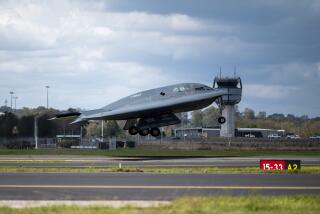Air Force Pinpoints Pesky Flaws in Stealth Bomber : Defense: Decision is pending on changes to forward edge of wing. Gains reported on B-2’s ability to elude detection.
- Share via
WASHINGTON — The Air Force said Thursday it has identified problems hampering the revolutionary B-2 bomber’s radar-evading capabilities and predicted that repairs would not force the program over its projected $44.4-billion cost.
But a decision on whether to modify the aircraft, which was designed to sneak through Soviet air defenses, will await further cost studies, said Air Force Secretary Donald B. Rice.
“The B-2 design is sound,” Rice told reporters. “We have today every confidence . . . that the B-2 will be the highly survivable aircraft that had been intended.”
The airplane, he said, “has passed with flying colors” a yearlong battery of tests designed to diagnose and address the source of the failure. Those earlier results led to a serious erosion of political support for the B-2 program, which the Defense Department cut last year from 75 to 20 aircraft.
The new test results are expected to clear the way for Congress to fund the last four of those 20 aircraft.
Air Force experts asserted last year that the plane’s problems were not the result of a basic design flaw. But lawmakers demanded proof of such claims, along with assurances that the plane could evade radar to the degree the Air Force originally advertised.
Rice said the findings announced Thursday, which were presented to Defense Secretary Dick Cheney earlier this week, ruled out the possibility that a design problem was responsible for the fault. Instead, improvements would focus on the material lining the forward edge of the plane’s boomerang-shaped body.
“There’s no problem with the basic planned form of the airplane, no problem with the underlying structure,” said Rice. “Anything we would end up doing is going to be relatively low-cost and at the margins, rather than something that would be high-cost or would raise a question about whether you ought to go on with the production program.”
With the demise of the Soviet Union--whose air defense network the Stealth bomber was designed to penetrate--experts have told the Air Force it may not be worth spending additional money to meet Stealth performance goals set a decade ago. Rice said Thursday that the service is seriously considering such advice, but stressed that it is nonetheless important to clear up questions about the program in the face of congressional skepticism.
“Given the reaction to the test anomaly that arose last year, if we could possibly do it, we wanted to show that we could meet” the radar-eluding specifications, Rice said. “And we have shown that.”
Rice said the cost of fixing existing aircraft would be borne by the U.S. government, but the plane’s Los Angeles-based manufacturer, Northrop Corp., would bear the additional costs involved in building the modifications into new planes.
Rice added that the past year’s probe into the bomber’s performance has yielded new techniques to measure and improve an aircraft’s ability to elude radar detection. He called the new body of diagnostic techniques “a national treasure,” and said it could be used to enhance the stealthiness of a wide range of U.S. weapons.
The B-2 is designed to be America’s second radar-evading aircraft. Older F-117A Stealth fighters were used against Iraqi targets with success in the Gulf War.
Only 59 of the F-117As were built by Lockheed Corp., which no longer manufactures the airplane.
An F-117A crashed late Tuesday near Holloman Air Force Base in New Mexico and the pilot ejected safely. The Air Force is investigating that crash and has not determined a cause, according to officials.
More to Read
Inside the business of entertainment
The Wide Shot brings you news, analysis and insights on everything from streaming wars to production — and what it all means for the future.
You may occasionally receive promotional content from the Los Angeles Times.











